Bodyboarding offers a unique blend of excitement, accessibility, and versatility, making it an ideal choice for water sports enthusiasts.
It is easier to learn than surfing, windsurfing, or kite surfing, making it a great option for beginners to enter the cool world of watersports.
It is not only easy to learn, but it is also suitable for people of all ages and fitness levels, providing an adrenaline-pumping experience without the steep learning curve of surfing or that you already have to be super fit and strong.
In addition: You need very little equipment (board, rashguard, and later fins). All the equipment is small, light, and inexpensive to purchase.
This sport promotes physical fitness and balance, as well as mental well-being by fostering a connection with nature. Bodyboarding also encourages camaraderie and social interaction among participants, making it a thrilling and enriching water sports option.
In summary the biggest advantages of Bodyboarding over other watersports are:
- It is easy to learn compared to surfing, windsurfing, or kite surfing
- It is cheaper to buy the material
- It makes huge fun even if you’re a beginner
- You need less equipment which means less storage space and less material to transport

Bodyboarding vs. Surfing
Bodyboarding and surfing are both water sports that involve riding waves, but they have some key differences in terms of equipment, technique, and skill level required.
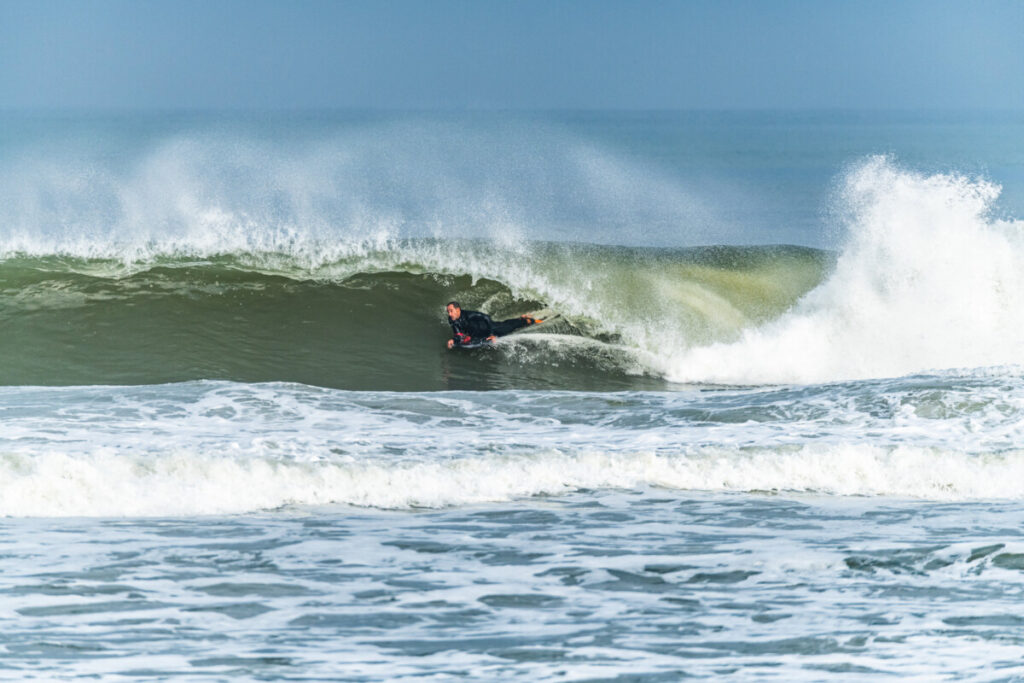

Key differences between Bodyboarding and Surfing:
Equipment: The most obvious difference between bodyboarding and surfing is the equipment used. Bodyboarding uses a smaller, foam-based board called a bodyboard or boogie board, which is typically around 3 to 4 feet long and cost in the range of 150$ to 200$ for a good quality product. On the other hand, surfing uses a much larger, rigid board called a surfboard, which can range from 5 to 12 feet in length. The average cost of a surfboard is about 500$.
Technique: In bodyboarding, the rider lies on their stomach, using their arms and fins to propel themselves through the water and onto the waves. Bodyboarders can also ride on their knees (Drop-Knee Bodyboarding), but they rarely stand on their boards. In surfing, riders stand up on the surfboard and use their feet to shift their weight and control their direction.
Stability: Due to the technique that you ride in a prone position, it is easier to balance and ride on a wave with a bodyboard compared to standing on a surfboard. This makes bodyboarding a more accessible sport for beginners, children, and those with less experience in the water.
Maneuverability: Bodyboarding allows for more radical maneuvers, such as spins and flips, that are generally harder or riskier to execute on a surfboard. This is because the rider’s lower center of gravity on a bodyboard enables them to maintain better control during these moves. Don’t get me wrong: in surfing, you can also do very radical moves, but it takes a lot more practice and skill.
Wave selection: Bodyboarders typically have a wider range of waves they can ride, including smaller and slower waves. This versatility means that bodyboarders can often find more suitable waves to ride in various conditions. In contrast, surfers often prefer longer and more open waves to execute their maneuvers.
Skill level: Bodyboarding is much easier to learn than surfing, making it a popular choice for beginners or those who want a quicker entry into wave riding. However, both sports have their own set of advanced skills and techniques that require time and practice to master.
Bodyboarding might be a better option for some individuals for the following reasons:
Accessibility: With its more stable platform and lower skill threshold, bodyboarding is a great option for beginners, children, or those who might have difficulties with the balance and coordination required for surfing.
Versatility: Bodyboarding allows riders to enjoy a wider range of wave conditions and types, making it an attractive option for those living in areas with less predictable surf conditions.
Physical demands: Bodyboarding may be less physically demanding than surfing, particularly on the upper body and legs, making it suitable for those with injuries or physical limitations.
Safety: Since bodyboarding typically takes place in shallower waters and closer to the shore, riders may feel less intimidated or at risk than when attempting to surf larger, more powerful waves.
Conclusion
In conclusion, while both bodyboarding and surfing are enjoyable and exciting water sports, the advantages of bodyboarding may be a more accessible and versatile option for some individuals, particularly beginners or those with physical limitations.
However, it’s important to note that every person’s abilities and preferences are different, and what works for one person may not work for another.
Bodyboarding vs. Stand-up Paddleboarding
Bodyboarding and Stand-up paddleboarding is both popular and enjoyable water sports that cater to different preferences and skill levels. While we love both activities and acknowledge that they each offer a unique experience, it is important to highlight the key differences between them and explain why some individuals might find bodyboarding more accessible and thrilling.
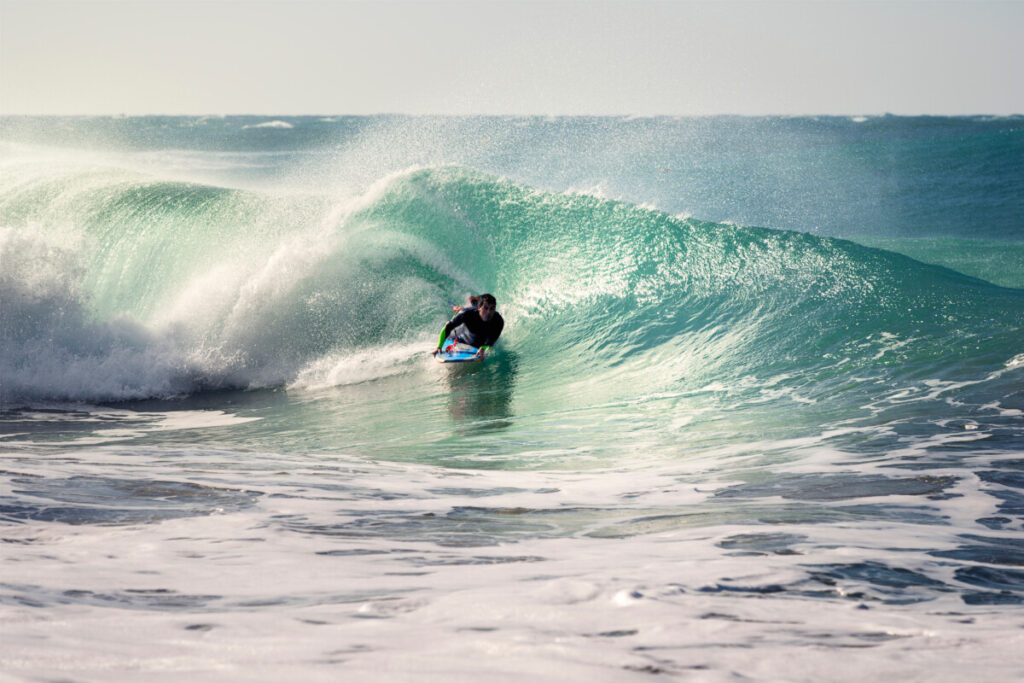
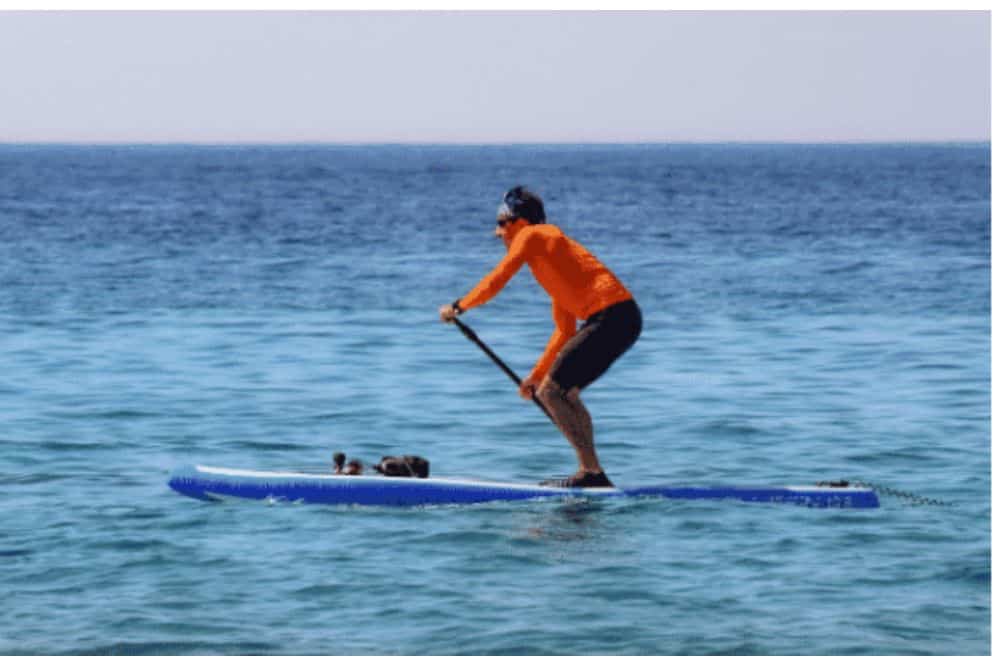
Key differences between Bodyboarding and Stand-Up Paddleboarding:
Technique and Equipment: Bodyboarding involves riding a small rectangular board while the rider lies down on their stomach, usually hanging onto the sides for added stability. Bodyboarding typically requires smaller equipment, making it more portable and easier to transport compared to stand-up paddleboarding.
Stand-Up Paddling involves standing on a large and wide board while using a paddle to propel and maneuver through the water.
Stand-up paddleboarding generally requires larger equipment, which can be an obstacle in terms of transportation, storage, and handling. And you need to be aware that the variety of board types is consequently larger in SUP than Bodyboarding. Boards differ in their shape and size, depending on the intended usage.
Accessibility: Bodyboarding may be considered more accessible to beginners, as balancing on the small board is easier when lying down, compared to standing on a larger board (as in stand-up paddleboarding). However, you need access to spot where there are suitable waves.
Stand-up paddleboarding can be practiced in a variety of water conditions, including lakes, rivers, and oceans, making it adaptable and exciting for different environments. While we absolutely love stand-up paddling, it might be considered less accessible to those who initially struggle with balance or coordination, as standing on a moving board can be challenging.
Physical demands: Bodyboarding needs some basic fitness, but not more. This sport can be practiced both in small waves for novices, as well as in large and powerful waves for experienced riders, making it very physically demanding. Bodyboarding is often perceived as more thrilling due to its closer proximity to the waves, allowing riders to be more immersed in the action, as they can catch, ride, and maneuver through fast-breaking waves.
Stand-Up Paddleboarding offers a more relaxed, steady experience compared to bodyboarding, as typically the emphasis is placed on paddling and navigating through calmer waters. But with a little experience and practice, even a stand up paddleboarder can jump into the waves and pull some cool moves.
The biggest advantage of stand up paddling is that you can control the physical load very easily. Paddling hard and going fast is one of the best full body workouts. But you can also do a leisurely and relaxed tour where you don’t really get to puff.
Conclusion
In conclusion, bodyboarding and stand-up paddleboarding are both fantastic water-based activities that cater to a wide range of people.
While stand-up paddleboarding offers a more relaxed and versatile experience, bodyboarding may be seen as a more accessible and thrilling option for some, especially for those in search of adrenaline-charged moments or individuals who would like to try a water sport without the need for advanced balancing skills.
Regardless of which one you choose, both sports allow for easy learning and are enjoyable right from the start!
However, the main advantages of Bodyboarding are the cheaper and smaller equipment as well as the bigger adrenaline rush right from the beginning.
Bodyboarding vs. Kayaking
Bodyboarding and kayaking are two distinct watersports that provide enjoyment and excitement for their respective enthusiasts. While there are similarities in that both involve navigating through water and facing challenges from the environment, there are some significant differences between the two.

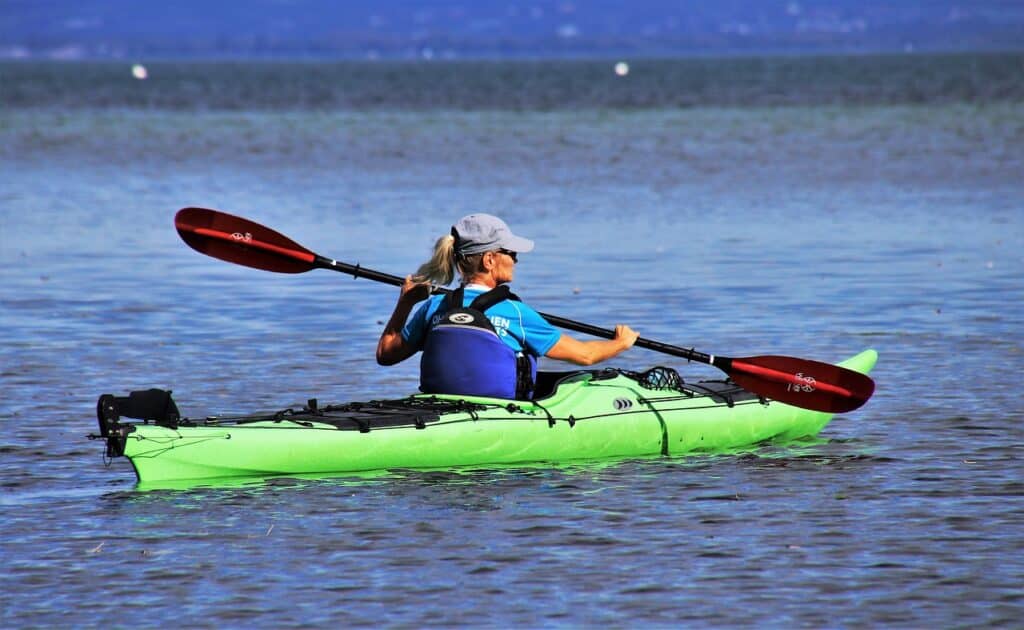
Key differences between Bodyboarding and Kayaking:
Equipment: Bodyboarding utilizes a compact foam board that the rider lays on, using their own body to steer and propel themselves through the waves. Kayaking, on the other hand, involves using a small boat-like vessel called a kayak with a double-bladed paddle as a means of propulsion. The prize of a qualitatively good kayak is significantly higher and can range up to 2000$.
Water Environment: Bodyboarding typically occurs in ocean environments, where individuals ride on waves toward the shore. In contrast, kayaking can be done in various water settings like oceans, rivers, and lakes, and generally involves navigating calm or rough waters without relying on waves.
Skills and Techniques: Bodyboarding requires a strong understanding of wave patterns and the ability to perform on-the-fly adjustments to your body’s positioning on the board. Kayaking focuses more on efficient paddling techniques and navigating various water conditions like rapids, currents, or open water.
Physical Exertion: Bodyboarding often demands more intense physical exertion as participants constantly paddle, kick, and maneuver their bodies in response to dynamic wave conditions. Kayaking can involve high-intensity paddling as well but varies depending on the specific activity and water conditions.
Adrenaline Factor: Some individuals may find bodyboarding to be a more exciting and challenging option due to the thrill of catching and riding waves, and the unpredictable nature of wave conditions. Kayaking provides adventure as well, but the adrenaline rush may not be as intense, depending upon the water conditions.
Risk Factor: Bodyboarding entails a higher risk factor when dealing with large waves, shallow reef breaks, and potential wipeouts. Kayaking risks include capsizing in rough waters, getting caught in strong currents, and potential collisions with underwater obstacles.
Learning Curve: Both sports have a learning curve, but bodyboarding may be easier to pick up initially, especially for those with a strong swimming background. Kayaking requires mastering paddle techniques and boat balance, which may take some time for beginners to become comfortable with.
Conclusion
Finally, one advantage of bodyboarding is, that it may be considered a more exciting and challenging option for some individuals due to the dynamic and adrenaline-inducing nature of riding waves compared to navigating various water environments with kayaking. Furthermore, the equipment you need is much cheaper and smaller and therewith easier to transport and store.
However, personal preferences, physical abilities, and the desired experience will ultimately dictate which watersport an individual chooses to partake in.
Bodyboarding vs. Windsurfing and Kite Surfing
Bodyboarding, windsurfing, and kitesurfing are three popular water sports, each offering its own unique thrills and challenges. Although all of these sports involve riding on the water’s surface, they provide very distinct experiences based on their equipment, technical demands, and overall vibes.
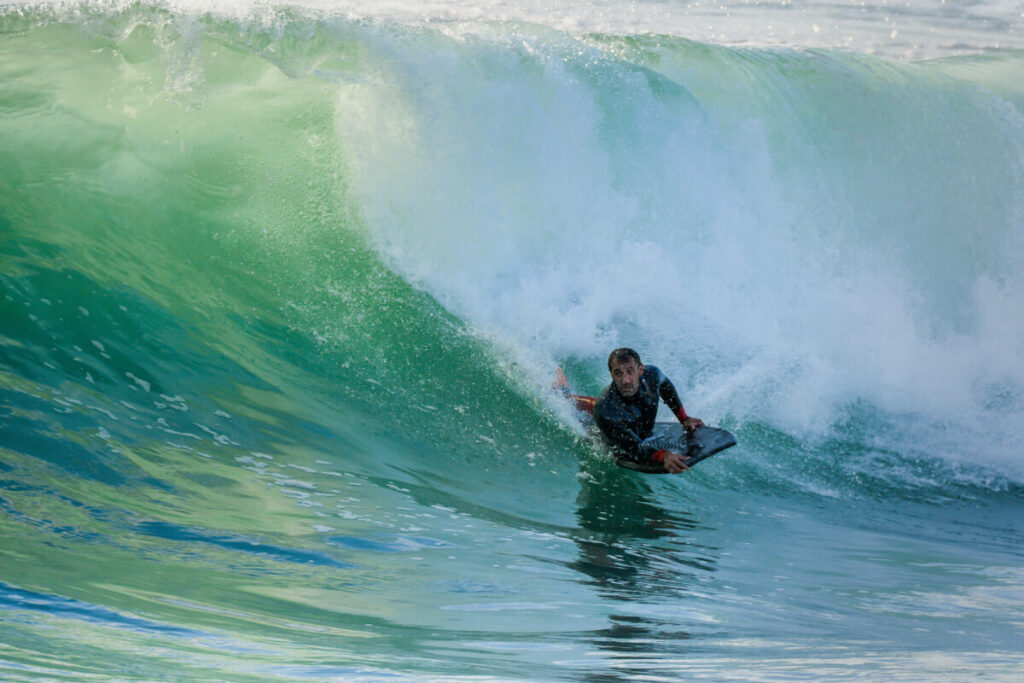
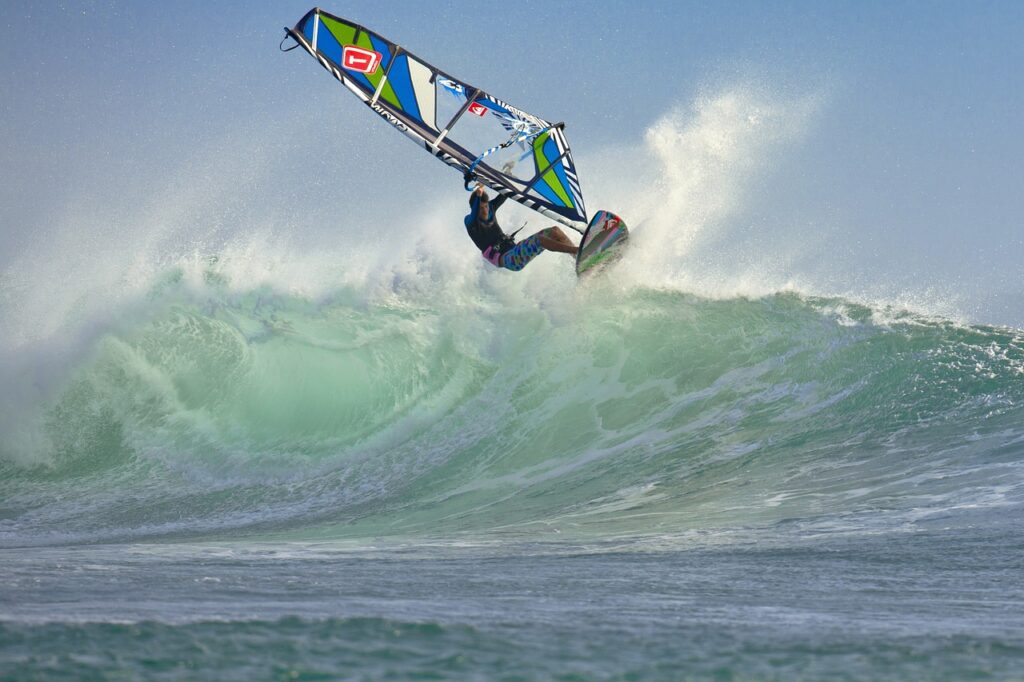
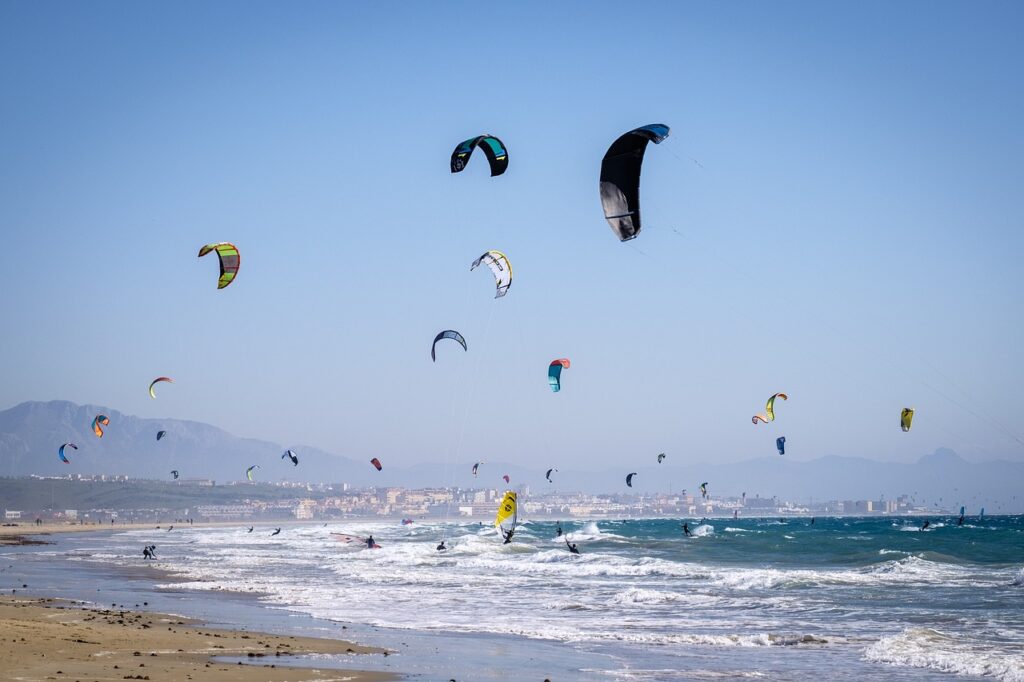
Key differences between Bodyboarding and Windsurfing / Kitesurfing:
Technique: Bodyboarding is a type of wave riding in which users lie prone on a small foam board and use their bodies and fins to paddle and maneuver the board into waves. It offers an intimate connection with the water and can be enjoyed in a wide range of wave conditions by people of all ages and fitness levels.
In contrast, windsurfing combines elements of surfing and sailing by having riders stand on a board with a sail attached. The sail is used to harness wind power, enabling windsurfers to glide across the water at remarkable speeds.
Kitesurfing is a relative newcomer to the water sports scene and takes the wind-powered action a step further by combining aspects of wakeboarding, surfing, and paragliding. Riders stand on a board, similar to a wakeboard or surfboard, while holding onto a large kite that propels them through the water and into the air for impressive jumps and aerial maneuvers.
Accessibility: Bodyboardingg the most accessible of the three, as it does not require mastery of complex techniques or the use of bulky equipment. Your learning curve will be very steep. Bodyboarding appeals to those who enjoy the simplicity of catching and riding waves in their most unadulterated form.
Windsurfing and Kitesurfing are much harder to learn, whereas for me Windsurfing was by far the hardest. However, for both you must develop a keen awareness of wind direction and strength, as well as the ability to balance and shift their weight on the board to control speed and direction.
Equipment: In bodyboarding, as already mentioned, you need very little and inexpensive material. A board, a rashguard and some fins are more or less all you need.
For windsurfing you need a significantly larger budget. In addition to the board, which costs a lot more and is larger, it is advisable to have several sails of different sizes and take them with you so that you can be out and about in different wind strengths. In addition to a rashguard or wetsuit, you also need a harness. So to buy a complete equipment set, you easily spend more than 3000$.
The situation with kitesurfing is similar. The board is also small, but you still need one or more kites in different sizes and a harness. And the kites in particular are not necessarily cheap and cost between 900$ up to 2000$.
Adrenaline Factor: Here, all three sports excel. Either through impressive waves (Bodyboarding), high speeds (Windsurfing) or huge jumps (Kitesurfing): All three offer definitely enough potential for an adrenaline rush.
Physical Exertion: Bodyboarding is a great full-body workout and particularly trains the upper body and legs when paddling. However, it definitely requires less strength and fitness than kitesurfing and especially windsurfing.
Conclusion
Ultimately, choosing between bodyboarding, windsurfing, and kitesurfing boils down to personal preference and the type of experience one wishes to have in the water.
For laid-back wave riding, bodyboarding may be ideal, while those seeking high-speed action and technical challenges may gravitate towards windsurfing or kitesurfing. Regardless of the choice, all three sports offer a thrilling means to connect with nature and enjoy the power of wind and waves.
However, from my personal view the main advantages of Bodyboarding are the cheap costs of the equipment and its small size.
Other Advantages of Bodyboarding
Summarizing, the advantages of bodyboarding over other watersports are the following :
1. Affordability: Bodyboarding is a relatively inexpensive watersport compared to other options like surfing, stand-up paddleboarding or windsurfing. All that is required is a bodyboard, fins, a leash, and a wetsuit (in colder conditions) or a rashguard (in warmer conditions), which can all be purchased at a reasonable price. Additionally, bodyboarding lessons (if needed) are often more affordable than lessons for other watersports.
2. Ease of travel: Bodyboards are conveniently lightweight and compact, making them easy to transport when traveling and storing. They can be easily packed into a car, or checked in as luggage when flying. Additionally, given their size, bodyboards can be easily carried to and from beaches, unlike other larger watersports equipment such as surfboards and sailboards.
3. Versatility: Bodyboarding can be enjoyed in various water conditions, from small, calm waves to larger swells. This makes it suitable for beginners and experienced riders alike and can be enjoyed at almost all types of beach breaks. Additionally, bodyboarding can also be practiced in different ways, such as prone riding (lying down) or drop-knee (kneeling), providing a range of options for different preferences and skill levels.
4. Accessibility: Bodyboarding is a relatively easy watersport to learn, making it an excellent choice for beginners or people who are not confident swimmers. It requires less balance and coordination compared to sports like surfing or windsurfing and can be enjoyed by people of all ages and fitness levels.
5. Safety: Bodyboarding is typically safer than some other watersports, as the speed and height achieved during a ride are often lower compared to surfing or kiteboarding. The soft foam material of the bodyboard also offers protection in the event of a collision or fall, reducing the risk of injury.
6. Fitness benefits: Bodyboarding is a great way to improve cardiovascular fitness, as it requires continuous paddling and kicking against the force of the waves. It also engages various muscle groups, such as those in the arms, shoulders, back, and legs, making it an excellent full-body workout.
7. Social aspect: Bodyboarding is a popular watersport and attracts a friendly and supportive community. This can provide opportunities to make new friends, connect with like-minded individuals, and learn from more experienced riders. Additionally, because it is accessible to a wide range of ages and skill levels, it can be enjoyed with friends or as a family activity.
8. Eco-friendly: Bodyboarding is an environmentally friendly watersport, as it requires no motorized equipment or fuel consumption. Additionally, since bodyboards are typically made from lightweight foam, they have a relatively lower environmental impact compared to the production of surfboards, which often involve the use of more harmful materials like fiberglass and resin.
Conclusion
If you are tired of the usual beach-time activities and looking for something fun, thrilling, and full of adventure? Why not try bodyboarding – a fantastic watersport option that offers a unique and exhilarating experience for people of all ages and skill levels?
Bodyboarding, often considered a cousin to surfing, involves riding the waves on a smaller, flexible board using your body’s buoyancy and balance. This exciting watersport offers numerous benefits and an adrenaline-pumping experience you’ll remember for a lifetime.
The reasons to consider bodyboarding as your next watersports venture are: It’s easy to learn and suitable for all ages and abilities, it’s affordable, it improves your fitness, and connects you with pure nature.
So, are you ready to embrace the world of bodyboarding?
Seize the day, grab a board, and set out on your new thrilling adventure that promises endless waves of excitement and fun. Give it a try, and you’ll soon discover why bodyboarding is an incredible watersport that everyone should consider adding to their ocean activities bucket list. Happy riding!






